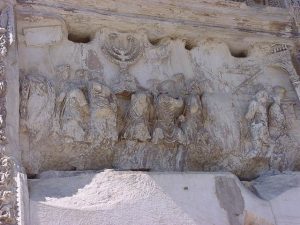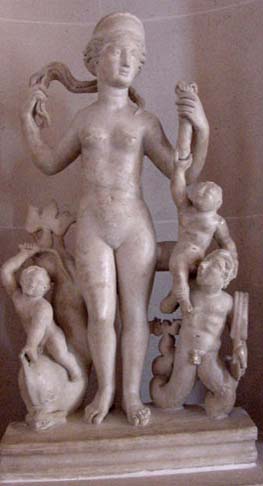
Roman soldiers carry a large Jewish menorah in a victory parade on the Arch of Titus.
Roman art of the first and second centuries AD pretty much continued the traditions of portraiture and Greek imitations. Roman artists added more use of art as propaganda to show what the emperors wanted people to know or to think. Some examples of this are the Arch of Titus and Trajan’s Column. This trend continued with the Column of Marcus Aurelius and then the Arch of Septimius Severus, and probably other columns and arches that didn’t survive for us to see them.

An Egyptian portrait of two brothers (Roman period, about 150 AD)
Of course there are also local variations all over the Roman Empire. An empire which covered most of Europe and all around the Mediterranean could hardly have only one art style all over it. The Gauls continued their art styles from before the Romans came. They found ways to mix their old art styles with new Roman ideas. So did the Britons, and the Spanish, and the Carthaginians, and the Phoenicians, and so forth.
With the third century AD (around 200 AD) several new ideas come into Roman art.
First, the wars with the Germans in the north were accompanied by a new taste for bloodshed in art. So monuments produced in the 200s AD, like the column of Marcus Aurelius, often show people having their heads cut off or their guts ripped out. Or they’re suffering in some other way. You can also see this on the Arch of Septimius Severus.

Column of Marcus Aurelius: Roman soldiers cut off the heads of Dacian prisoners.
Second, there was an increasing use of the drill rather than the chisel to make sculpting easier and faster, giving a somewhat different look.
Third, there was at the same time a new concern for the soul, maybe because there were more and more Christians in the Roman Empire. In art, this shows up as a lot of emphasis on the eyes (the windows to the soul), often with the eyes looking upward to heaven, or toward the gods. At the same time, because the body is less important, the sculptors take less care to show the body accurately. Sometimes the arms and legs are too short, and the head tends to be too big. Apparently they didn’t think those things were important. Or they wanted to emphasize the head, because that seemed like the most important part of the human body.

Venus rising out of the ocean (300s AD, now in the Louvre)
In the fourth century (the 300s) AD, there is less blood and gore, but the interest in the soul and the tendency to show that by big eyes and abstract, unreal bodies continues right up to the fall of Rome. This piece (from the Louvre) shows the goddess Venus rising out of the ocean.
Learn by doing: try to draw a person with all their parts the right size: measure arms and legs and head and hand size to get it right
More about Byzantine Art
Bibliography and further reading about Roman art:
Ancient Roman Art, by Susie Hodge (1998). Easy reading.
Roman Art: Romulus to Constantine, by Nancy and Andrew Ramage (4th Edition 2004). The standard textbook.
A Coloring Book of Ancient Rome, from Bellerophon Books (1988). Easy reading.




